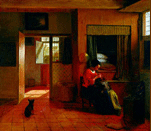










This session has three objectives: to introduce the study of material history as a rewarding approach to Italian Renaissance art; to demonstrate the advantages of adopting this approach, with particular reference to its implications for the study of Renaissance women; and to indicate the ways in which scholars and teachers in all disciplines might adopt material culture studies on a wider scale. In addition, by featuring a session exploring new directions in art history and material culture, conference organizers hope to make these fields more central to interdisciplinary conversations about the study of early modern women's lives and works.
Allerston and Welch will describe how both art historians and historians have employed the methods of material culture studies and expanded the definition of art to include diverse objects, such as maiolica tableware, tapestries, and marriage chests, as well as clothes, jewellery, lace, and embroidery.
This approach has great potential for the study of early modern women. A significant percentage of these objects were used within the home; they therefore had specific and important associations with women and give scholars great insights into women's lives in the Renaissance.
To illustrate the advantages of this approach, the speakers will screen excerpts from "Venice: A Second-hand City?", a recent BBC-Open University television program in the award-winning "Renaissance Secrets" series. The program exposes the difference between the public face of the city, as represented by its opulent art, architecture, and objects, and the sometimes-sordid reality that lay behind it. Clothes, furniture, art, and even people were pawned regularly, and women in particular fell into a spiral of debt and sometimes faced prostitution just to purchase fashionable objects.
The speakers will also present the collaborative research project, "The Material Renaissance: Costs and Consumption in Italy, 1400-1650". The scholars involved in this project examined the prices of different types of goods over both time and place, and the market for both domestic goods such as food and clothing and for objects now considered "art," particularly panel paintings, metalwork, and antiquities. These scholars debate whether the relationship between the marketplace and individual or institutional artistic patronage changed during the Renaissance. They also explore whether art objects were, as is usually assumed, bought and sold in ways that distinguished them from other commodities. Finally, they question the gendered nature of Renaissance consumption, examining how social communities of buyers and sellers were formed, and exploring the different means by which objects were acquired in different communities.
As a conclusion to their presentation, the speakers will summarize their own current research to demonstrate the ways in which Renaissance art can be investigated through material culture. Evelyn Welch will discuss her forthcoming book, a history of shopping in Renaissance Italy. Patricia Allerston emphasize the need to consider more ephemeral objects, such as papier mâché sculptures, wax devotional objects, and cheap prints, within larger examinations of Renaissance art. The speakers will then open the floor for discussion among symposium participants.
last updated September 12, 2003
|
|
|
||||||
|
|
 |
 |
|
||||
 |
|
 |
|
||||
|
|
|
||||||
|
|
|
||||||
 |
|
||||||
|
|
|
||||||
| |
|
||||||
 |
|
||||||
 |
|
||||||
 |
|
||||||
 |
|
||||||
|
|
|
||||||
|
|
 |
|
|
||||
 |
|
||||||
|
|
|
|
|
|
|
|
|